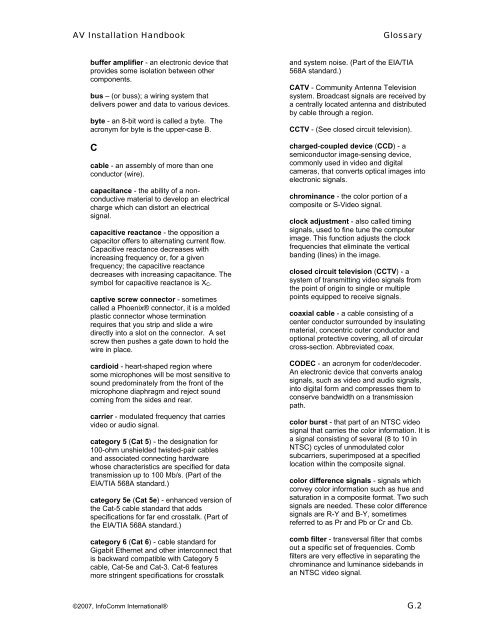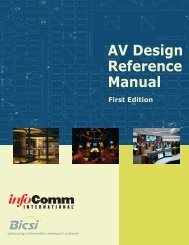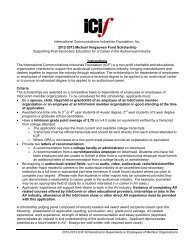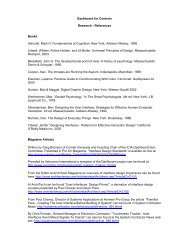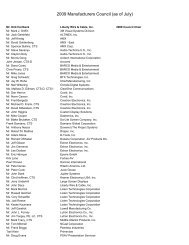Download - InfoComm
Download - InfoComm
Download - InfoComm
Create successful ePaper yourself
Turn your PDF publications into a flip-book with our unique Google optimized e-Paper software.
AV Installation Handbook<br />
Glossary<br />
buffer amplifier - an electronic device that<br />
provides some isolation between other<br />
components.<br />
bus – (or buss); a wiring system that<br />
delivers power and data to various devices.<br />
byte - an 8-bit word is called a byte. The<br />
acronym for byte is the upper-case B.<br />
C<br />
cable - an assembly of more than one<br />
conductor (wire).<br />
capacitance - the ability of a nonconductive<br />
material to develop an electrical<br />
charge which can distort an electrical<br />
signal.<br />
capacitive reactance - the opposition a<br />
capacitor offers to alternating current flow.<br />
Capacitive reactance decreases with<br />
increasing frequency or, for a given<br />
frequency; the capacitive reactance<br />
decreases with increasing capacitance. The<br />
symbol for capacitive reactance is X C .<br />
captive screw connector - sometimes<br />
called a Phoenix® connector, it is a molded<br />
plastic connector whose termination<br />
requires that you strip and slide a wire<br />
directly into a slot on the connector. A set<br />
screw then pushes a gate down to hold the<br />
wire in place.<br />
cardioid - heart-shaped region where<br />
some microphones will be most sensitive to<br />
sound predominately from the front of the<br />
microphone diaphragm and reject sound<br />
coming from the sides and rear.<br />
carrier - modulated frequency that carries<br />
video or audio signal.<br />
category 5 (Cat 5) - the designation for<br />
100-ohm unshielded twisted-pair cables<br />
and associated connecting hardware<br />
whose characteristics are specified for data<br />
transmission up to 100 Mb/s. (Part of the<br />
EIA/TIA 568A standard.)<br />
category 5e (Cat 5e) - enhanced version of<br />
the Cat-5 cable standard that adds<br />
specifications for far end crosstalk. (Part of<br />
the EIA/TIA 568A standard.)<br />
category 6 (Cat 6) - cable standard for<br />
Gigabit Ethernet and other interconnect that<br />
is backward compatible with Category 5<br />
cable, Cat-5e and Cat-3. Cat-6 features<br />
more stringent specifications for crosstalk<br />
and system noise. (Part of the EIA/TIA<br />
568A standard.)<br />
CATV - Community Antenna Television<br />
system. Broadcast signals are received by<br />
a centrally located antenna and distributed<br />
by cable through a region.<br />
CCTV - (See closed circuit television).<br />
charged-coupled device (CCD) - a<br />
semiconductor image-sensing device,<br />
commonly used in video and digital<br />
cameras, that converts optical images into<br />
electronic signals.<br />
chrominance - the color portion of a<br />
composite or S-Video signal.<br />
clock adjustment - also called timing<br />
signals, used to fine tune the computer<br />
image. This function adjusts the clock<br />
frequencies that eliminate the vertical<br />
banding (lines) in the image.<br />
closed circuit television (CCTV) - a<br />
system of transmitting video signals from<br />
the point of origin to single or multiple<br />
points equipped to receive signals.<br />
coaxial cable - a cable consisting of a<br />
center conductor surrounded by insulating<br />
material, concentric outer conductor and<br />
optional protective covering, all of circular<br />
cross-section. Abbreviated coax.<br />
CODEC - an acronym for coder/decoder.<br />
An electronic device that converts analog<br />
signals, such as video and audio signals,<br />
into digital form and compresses them to<br />
conserve bandwidth on a transmission<br />
path.<br />
color burst - that part of an NTSC video<br />
signal that carries the color information. It is<br />
a signal consisting of several (8 to 10 in<br />
NTSC) cycles of unmodulated color<br />
subcarriers, superimposed at a specified<br />
location within the composite signal.<br />
color difference signals - signals which<br />
convey color information such as hue and<br />
saturation in a composite format. Two such<br />
signals are needed. These color difference<br />
signals are R-Y and B-Y, sometimes<br />
referred to as Pr and Pb or Cr and Cb.<br />
comb filter - transversal filter that combs<br />
out a specific set of frequencies. Comb<br />
filters are very effective in separating the<br />
chrominance and luminance sidebands in<br />
an NTSC video signal.<br />
©2007, <strong>InfoComm</strong> International® G.2


